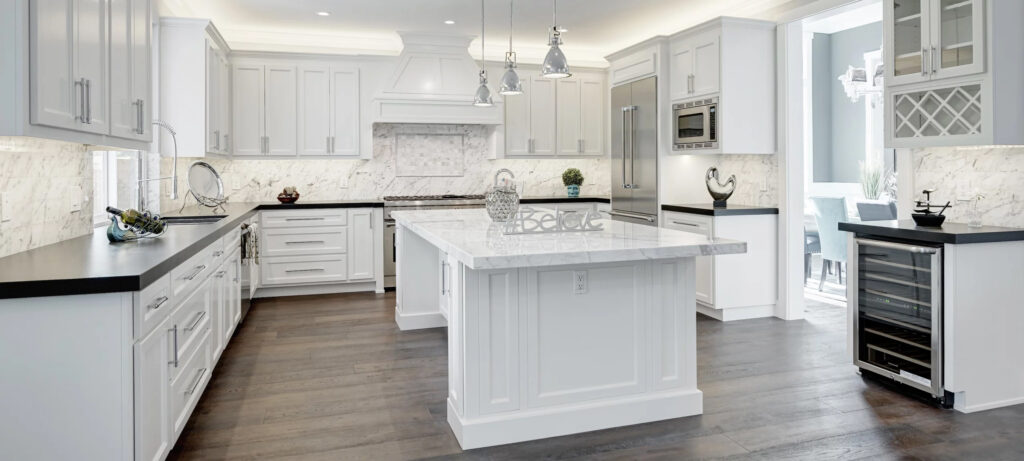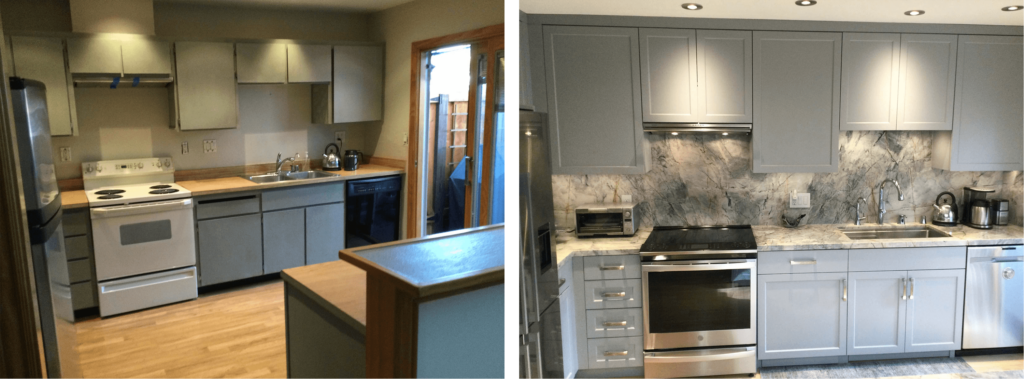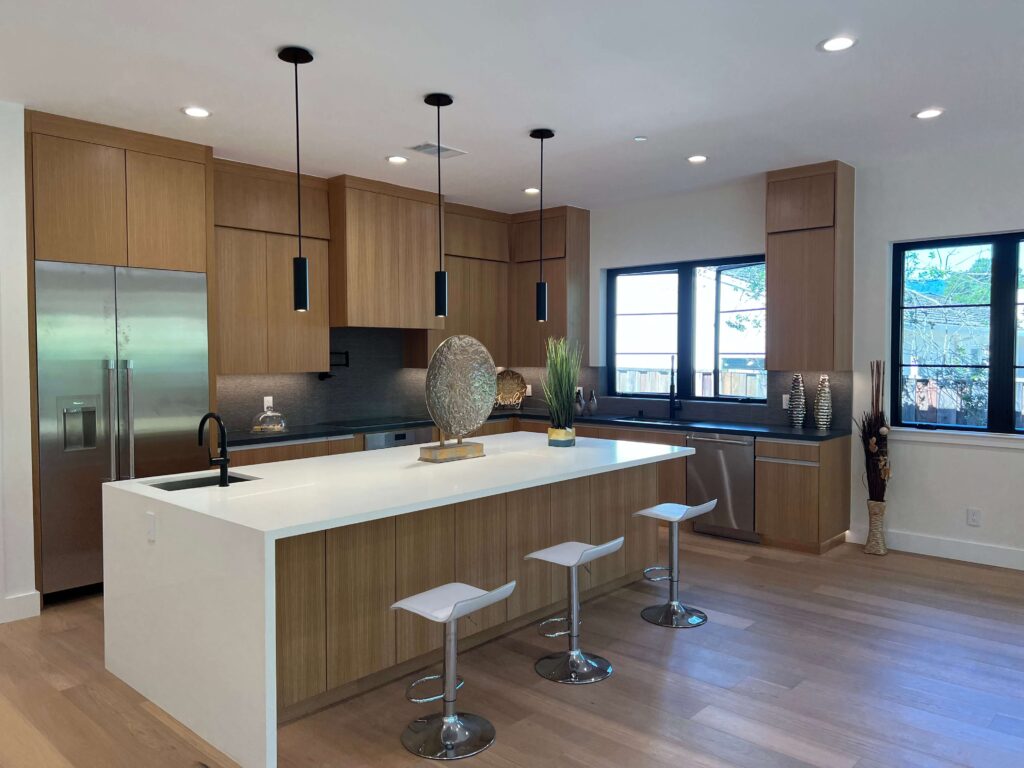Whether you hire a professional or do it yourself, designing a new kitchen or a kitchen remodel that is both attractive and functional requires careful planning. It is not a task that should be rushed.
For this article, our residential contractors have created a compilation of design decisions to help you consider your lifestyle and family needs and provide recommendations about kitchen layout, style, cabinetry, cabinet pulls, countertops and backsplashes, flooring and lighting.

The Kitchen Layout
A good place to begin the process of kitchen design is to identify the features of your current kitchen layout that you like and those that you don’t.
Common complaints about poorly planned kitchen layouts are that counter and storage space are insufficient, frequently used items are out of reach, and doors, drawers and appliance doors open in directions that block traffic or that hit each other when open.
A good rule of kitchen design is to ensure that there is sufficient space to allow unobstructed movement among the “golden triangle” – the refrigerator, sink and cooktop.
- As you think about options for the layout, determine how you will use your kitchen and whether you want areas dedicated to specific tasks such as preparing food, cooking, baking, washing dishes, washing pots and pans, making coffee, recharging electronics, preparing snacks for children, feeding pets, watching television, writing notes, doing homework, and storing food, dishes, utensils, serving trays and table coverings.
- If you have the space, perhaps you want to add an island to create storage space, an extra work surface, and a place for casual family meals.
- Or perhaps you want to add a separate “scullery” room to use for food prep, unpacking groceries, and receiving deliveries.
The Kitchen Style
Take time to reflect upon how you want your kitchen to look and feel. Do you prefer a look that is contemporary, modern, transitional, contemporary, Craftsman, Asian-inspired, European, industrial, rustic, or eclectic? Do you want to make a bold “Wow!” statement or do you want to create a feel that is elegant, or calming, or warm and homey?
A new or remodeled kitchen with the right “look and feel” is one that successfully blends carefully chosen colors, patterns, and styles to create the mood you desire. Professional designers suggest creating a “mood board” – a collage of colors, cabinet styles, and layouts that you find attractive. Houzz, Pinterest and design websites and magazines have photos that will spark your imagination.

With creative planning, you can turn a tired, outdated kitchen into a vibrant, modern kitchen!
Kitchen Cabinetry
When choosing cabinetry, consider style, material, and function. The three main types of cabinetry are stock, semi-custom, and custom. Stock cabinetry is usually the least expensive, but it offers a limited variety of configuration options. Semi-custom provides some customization at less than the cost of custom. Custom cabinetry can be designed to meet your needs, at a higher cost.
Quality mid-range, semi-custom cabinetry is a good investment, as it ages more gracefully and needs less upkeep than lesser grades, and may give a better return on your investment than top-of-the-line custom cabinetry if you are planning to sell your home within a few years.
Here are some of the many design decisions for you to make:
- Type – Which of the three-door/drawer types do you prefer: inset, partial overlay, or full overlay? Full overlay has a modern look, with no visible frame or hinges, allowing more usable space within the drawers and cabinets. As the space between doors and drawers is fractional, for a consistent look, full overlay cabinets are best installed by experienced professionals.
- Height – Ceiling height, lower, or suspended?
- Door and Drawer Styles – Uniform or mixed?
- Upper Doors – Solid or with decorative glass? Open shelving with no doors?
- Dish, Pot & Pan Storage – In drawers (popular) or on shelves?
- Food Storage – Pullout shelves (highly recommended) or fixed shelves?
- Small Appliance Storage – Pullout shelves or corner revolving shelves for mixer, blender, toaster, and other small appliances? (Some styles function well but cleaning in and around them is a challenge.)
- Unusual Items – Do you need storage space for any items with unusual sizes?
- Tow-Kick Drawers – Do you need extra space for storing trays, placemats, and serving platters? If so, think about adding toe-kick drawers in the three inches of wasted space underneath cabinets. Soft-close, full-extension drawers that open and close with a single kick of the toe offer an ingenious way of adding storage space to a kitchen.

Kitchen Organization
Do you prefer organized chaos or a place for everything? Below are some options:
- Spice racks
- Slim pullouts for hand towels, baking sheets, and large cooking utensils
- Insert for paper towel roll
- In-drawer tray for knives
- Secret drawers within drawers
- Wine storage area
- Pullout for pet dishes
- Alcove or pullout for microwave
- Pullout for waste and recycling baskets (Very convenient!)
- Pullout for composting container
- Slim pullout “closet” to store broom, fold-up step stool, and other tall, slim items
- Shelves or cabinets for storing recipe books
- Desk for doing paperwork
Contractor Recommendations:
- Choose a style and color that will blend well with the style and color of adjoining rooms. If you are considering the future resale value of your home, avoid extremes in style and color.
- Your cabinets should look as attractive on the inside as they do on the outside. While re-facing can give existing cabinets a new look, if they do not contain sufficient storage options, replacing them could be the better choice.
- To calculate how many shelves and drawers of various widths and depths you need, measure your dishes, pots, pans, small appliances, food items, trays, linens, decorative items, etc.
- Determine how many inches high you want the “lip” (front edge) of each pullout drawer to be. Find the sweet spot between ease of access and protection from items tumbling out.
- If your cabinets and walls will be painted, request that your building contractor or remodeling contractor leave you some of the cabinet paint and wall paint for touch-ups.
- You can protect your investment in new cabinets by adding shelf and drawer liners made of heavy-gauge, clear plastic sheeting cut-to-size.
Look for cabinets that have the following features:
- All-plywood construction
- Full-height back panels
- Soft-close hinges on doors
- Soft-close, full-extension, steel, undermount drawer glides
- Hardwood dove-tail drawer boxes
- Paint / finish or other material that is high quality, durable, cleanable, chip resistant and fade resistant.

Kitchen Cabinet Pulls
The door and drawer knobs and handles, known as “pulls,” are the “jewelry” of the kitchen. Take your time to choose pulls that you enjoy seeing and touching and that are durable, high quality, and resistant to peeling, pitting, tarnishing, denting or breakage.
- Style – Does the style of the pulls complement the style of the kitchen? Modern-style pulls can blend with shaker doors, for example, but might look awkward on Italianate or rustic-style doors. Ornate pulls might catch your eye but won’t be the best choice if you are planning to sell your home soon as they might not have wide appeal.
- Finish – Chrome, brushed nickel, and matte black are popular.
- Size – Many styles of pulls come in several sizes. Purchase samples of various sizes and hold them against your doors and drawers to see what size looks best on each. (Most stores will accept returns of unused items.)
- Positioning – Experiment with where to place each pull and let your residential licensed contractor know what placement you prefer before they begin to drill holes for installation. For a minimalist look, consider using no pulls on upper cabinets or no pulls at all if your cabinet style allows. (Discuss this with your contractor in advance, as many cabinet styles require pulls.)
- Ease of Use – Consider each member of the family. Larger hands might not slide easily into narrow drawer pulls and arthritic fingers might not be able to grab some knobs or handles easily.
- Feel – Feel the backsides of the handles and knobs. Those that are smooth to the touch are more comfortable to use.
- Lifetime Warranty – Look for pulls that come with an extended or lifetime warranty on wear.
- Extras – Purchase one extra pull of each size so that you will have a replacement in case of damage, as that style might go out of production in the future.

Kitchen Countertops and Backsplashes
When choosing countertop and backsplash materials, consider color, pattern, ease of daily care, resistance to stains, scratches and heat, and requirements for long-term maintenance.
You can create a uniform look by choosing a countertop and backsplash of the same material or you can create contrast by using complementary materials, colors, and patterns.
Before making final decisions, step back and determine how well your choices will integrate with the style and colors of adjoining rooms.
- Natural stone slabs such as quartzite, marble, and granite can look elegant and pass the test of time. Quartzite is harder and less porous than marble but still needs to be well-sealed to prevent staining or darkening. Make sure that your residential contractor uses a professional sealant and inquire about how often the materials should be re-sealed.
- Manufactured surfaces such as recycled glass, DuPont Corian, DuPont Zodiaq (engineered quartz), and Silestone by Cosentino are popular as they are heat resistant, non-porous, will not harbor mold or bacteria, and do not require sealing.
- Less commonly used surfaces include soapstone (non-porous and heat and bacteria-resistant), zinc (stylish, but scratches and warps easily), tile (can chip and crack and requires periodic grout cleaning and replacement), wood (subject to staining, scorch marks, and moisture damage if not properly sealed and resealed), stainless steel (subject to denting), and decorative laminate (can become outdated quickly).
- Height and Width of the countertops – Choose a height and depth that will be comfortable for users. The standard height is 36 inches from the floor and the standard depth is 24 inches.
- Edging (known as “bullnosing”) of the countertops is an important design detail. Choose a style (rounded, straight, etc.) and height (one to three inches of “overhang”) that will match the style of your kitchen (modern, Craftsman, etc.). To familiarize yourself with the variety of bullnose styles, you can visit kitchen stone and countertop showrooms.
Kitchen Flooring
Popular kitchen flooring materials include ceramic or porcelain tile, solid hardwood, and vinyl. Other possibilities include engineered hardwood, natural stone, concrete, bamboo, and linoleum.
Contractor Recommendations:
- When choosing flooring, consider the material, color, pattern, finish, size, shape, hardness, slip factor, ease of cleaning, and the likelihood of damage if water spills or a heavy item falls onto it.
- If choosing natural stone tiles, determine how porous the stone is and make sure they are well sealed with a professional sealant.
- If choosing ceramic tiles, determine if the color and design permeate the entire tile or if they are only on the surface. (Avoid the latter.) Choose good quality tile that is at least a quarter inch (ten millimeters) thick.
- Consider porcelain tile. It is more durable than ceramic tile, the color extends throughout the tile, and it is moisture resistant.
- Solid hardwood is a popular choice for kitchens. The pros of hardwood are that it can be sanded and re-stained. The cons are that it dents and scratches easily, and can be damaged by water. If choosing solid hardwood, determine its hardness rating on the Janka scale. Woods with a higher hardness rating such as oak and ash will dent less easily than softer woods such as pine or soft maple.
- If choosing engineered hardwood, determine if it really can be refinished. (Some manufacturers state that refinishing is possible but local flooring shops may say that it is not if the wear layer is less than three millimeters thick.)
- Bamboo is attractive and comes in a variety of styles but can be difficult and expensive to refinish.
- Linoleum is having a resurgence as kitchen flooring. It is attractive, durable, and, being made from many natural ingredients, is sustainable.
- If flooring will be installed on top of a concrete slab or near water, make sure that the installers seal any cracks in the concrete and do a moisture check. Moisture under the flooring can cause hardwood to warp, natural stone to change color, and grout to flake, chip or discolor. (Keep in mind that a moisture check done in the dry season might yield a false negative.) Paying a bit extra to have a moisture barrier installed under flooring can prevent unpleasant surprises in the future.
Choose flooring that will blend well with the flooring in adjoining rooms and consider installing an underfloor heating system to keep the floors toasty on colder days.

Kitchen Lighting and Electricity
Lighting is a crucial factor in how you will feel about your kitchen, so it pays to do careful research. Consider ambient lighting (whole room), task lighting (recessed lighting focused on countertops), and accent lighting (decorative).
Designer Recommendations:
- Adjustable recessed lighting around the perimeter
- Sufficient task lighting for each dedicated area
- Decorative pendant lights
- Under-cabinet lighting for elegance and nighttime convenience (This is well worth the extra cost!)
- Dimmers to adjust brightness on all lights
- Electric outlets placed above countertops (location will be determined by local code)
- Outlets placed behind any drawers that will store items requiring recharging (personal electronics, robotic floor washers, etc.) (Remind your residential contractor to put a hole in the back of each drawer for the electrical cord.)
- Special outlets for charging USB-compatible and Next Generation-compatible personal electronic devices
- Switch and Outlet Covers – Choose a color and material that will complement the backsplash and wall colors and purchase one extra of each size for use in the future if needed, as manufacturers change styles and colors every few years.
Pro Tips for Designing Your Kitchen
Designing a new or remodeled kitchen is a decision-intensive undertaking. With each decision, consider the look, features, durability, cost, ease of use, and maintenance requirements, and keep the following pro tips in mind:
- Look at the kitchen from all angles.
- Coordinate styles, colors, and patterns with those of adjoining rooms.
- Avoid using too many colors and patterns.
- Avoid using dark colors in small spaces.
- Provide sufficient counter and storage space.
- Plan so that doors and drawers will not conflict when open.
- Provide extra electrical outlets if needed.
- Plan a space for trash and recycling and for a broom and cleaning supplies.
- Choose materials and products that do not require more care than you want to give.
- Avoid design trends, as they can become outdated quickly.
- Choose flooring that is durable and that complements cabinets and countertops.
- Choose highly rated, high-quality materials.
- Add more pizzazz with textiles – rugs, hand towels, curtains, shades, etc.
With careful research and decision-making, you can create a kitchen that is attractive and functional and that you will enjoy for years to come!
We hope you have found this article useful and informative, and we appreciate your taking the time to read it. If you are interested in tips for choosing appliances for your new kitchen, please see our companion article.
At Bay Area Design & Construction, we would be pleased to work with you to create the new or remodeled kitchen of your dreams. Let our licensed team of home contractors bring your dreams to life! You can reach us here – Contact Us.
Share this post with your friends!
